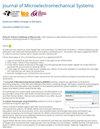Low-Energy Consumption Actuation for Microelectrothermal Actuators via Capacitive Discharge Excitation
IF 3.1
3区 工程技术
Q2 ENGINEERING, ELECTRICAL & ELECTRONIC
引用次数: 0
Abstract
Microelectrothermal actuators are widely used in various microelectromechanical systems (MEMS), but challenges related to energy consumption and response time persist, especially in energy-constrained systems. This paper presents an innovative approach to achieving low-energy consumption in microelectrothermal actuators through capacitive discharge excitation. A theoretical model is developed to analyze the actuator’s displacement, temperature, and response time as functions of applied voltage and capacitance. Experimental results validate the theoretical predictions, showing that with an applied voltage of 56 V and a capacitance of 0.1 mF, the actuator achieves a displacement of 160电容放电激励微电热执行器的低能耗驱动
微电热致动器广泛应用于各种微机电系统(MEMS),但能耗和响应时间方面的挑战一直存在,特别是在能量受限的系统中。提出了一种利用电容放电激励实现微电热执行器低能耗的创新方法。建立了一个理论模型来分析执行器的位移、温度和响应时间作为外加电压和电容的函数。实验结果验证了理论预测,在施加电压为56 V,电容为0.1 mF的情况下,执行器在7.65 ms内实现了160 $\mu $ m的位移,仅消耗0.157 J的能量。与传统的恒压激励(24 V)相比,电容放电激励方法能耗降低21.1%,响应时间缩短81.4%。此外,考虑到可用电容器规格的限制,提出了一种选择电容器的匹配策略。该研究强调,更高的施加电压和更低的电容导致更快的响应时间和更低的能耗,为节能MEMS应用提供了一个有前途的解决方案。(2024 - 0225)
本文章由计算机程序翻译,如有差异,请以英文原文为准。
求助全文
约1分钟内获得全文
求助全文
来源期刊

Journal of Microelectromechanical Systems
工程技术-工程:电子与电气
CiteScore
6.20
自引率
7.40%
发文量
115
审稿时长
7.5 months
期刊介绍:
The topics of interest include, but are not limited to: devices ranging in size from microns to millimeters, IC-compatible fabrication techniques, other fabrication techniques, measurement of micro phenomena, theoretical results, new materials and designs, micro actuators, micro robots, micro batteries, bearings, wear, reliability, electrical interconnections, micro telemanipulation, and standards appropriate to MEMS. Application examples and application oriented devices in fluidics, optics, bio-medical engineering, etc., are also of central interest.
 求助内容:
求助内容: 应助结果提醒方式:
应助结果提醒方式:


